Key takeaways:
- Understanding and choosing the right app development tools, like low-code platforms, can streamline workflows and enhance creativity.
- The prototyping phase is essential for testing ideas, fostering collaboration, and allowing for creative exploration without fear of finality.
- Engaging with peers and mentors provides fresh perspectives, igniting creativity and motivation while promoting accountability through collaboration.
- Incorporating user feedback is crucial for improvement, revealing blind spots and informing future developments to create a more user-friendly experience.

Understanding app development tools
When I first started diving into app development, I was overwhelmed by the vast array of tools available. Which one should I choose? This question haunted me until I realized the importance of understanding each tool’s specific purpose and functionality. Familiarizing myself with frameworks like React Native or Flutter has not only boosted my confidence but also expanded my creative possibilities.
The truth is, the right app development tool can significantly streamline your workflow. For instance, I remember spending hours on manual coding before discovering low-code platforms. It was like finding a shortcut in a maze, allowing me to focus on the creative aspects rather than getting bogged down in technicalities. It made me wonder: how many developers avoid experimenting with new tools out of fear of complexity?
Exploring app development tools is akin to gardening; each tool serves a unique purpose, just like different plants contribute to a balanced ecosystem. As I’ve cultivated my skills, I’ve learned to appreciate how these tools complement each other. If we take the time to understand each one, we can nurture our projects and watch them flourish. Have you ever considered how the tools you choose can transform your development experience?
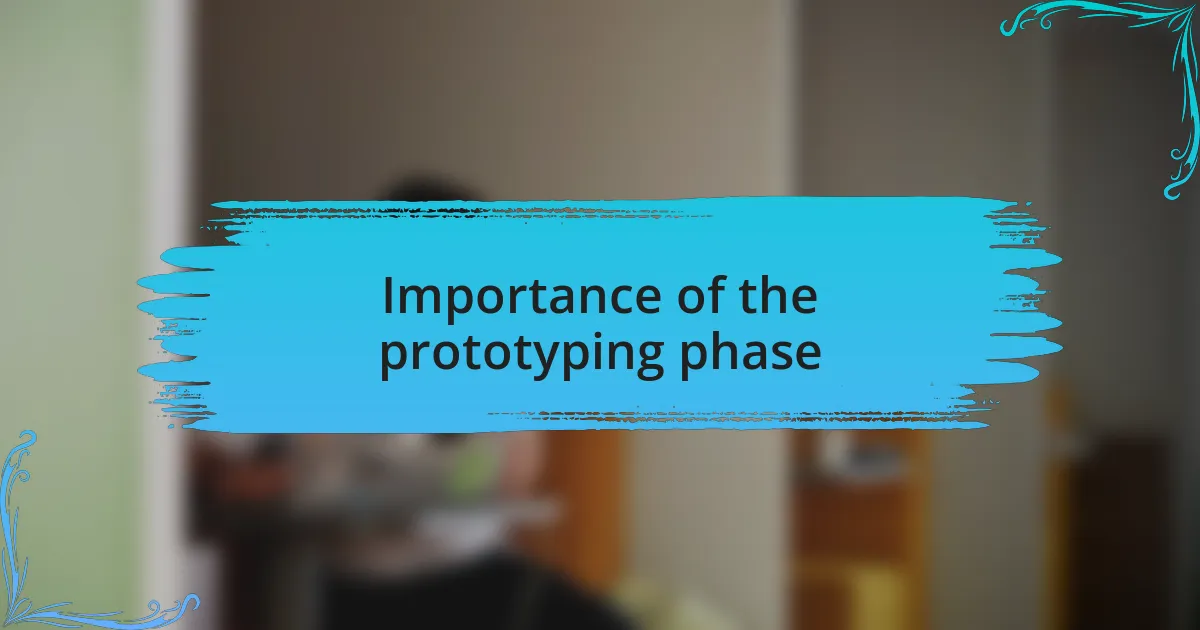
Importance of the prototyping phase
The prototyping phase is crucial in app development because it allows for testing ideas before committing significant resources. I remember the first time I created a prototype for a project; it was a game-changer. Seeing concepts come to life, even in a rough form, helped me identify weaknesses early on and allowed me to pivot quickly. How often do we rush to coding, only to realize later that our foundational ideas were flawed?
Another key aspect of prototyping is that it fosters collaboration and communication among team members. There was a project where I felt we were all on different pages. Once we introduced a prototype, it sparked discussions and allowed us to visualize the gaps in our understanding. I found that sharing a tangible representation made it easier for everyone to contribute their insights. Have you ever felt that a prototype could bridge a communication gap within your team?
Ultimately, prototyping not only saves time but also unleashes creativity. During one of my prototyping phases, I experimented with features I hadn’t considered initially. The freedom to explore without the fear of judgment or finality led to an innovative solution that became the project’s centerpiece. It made me realize that sometimes, the best ideas emerge when we give ourselves the space to play and iterate. Isn’t it refreshing to know that trial and error can lead us to unexpected brilliance?
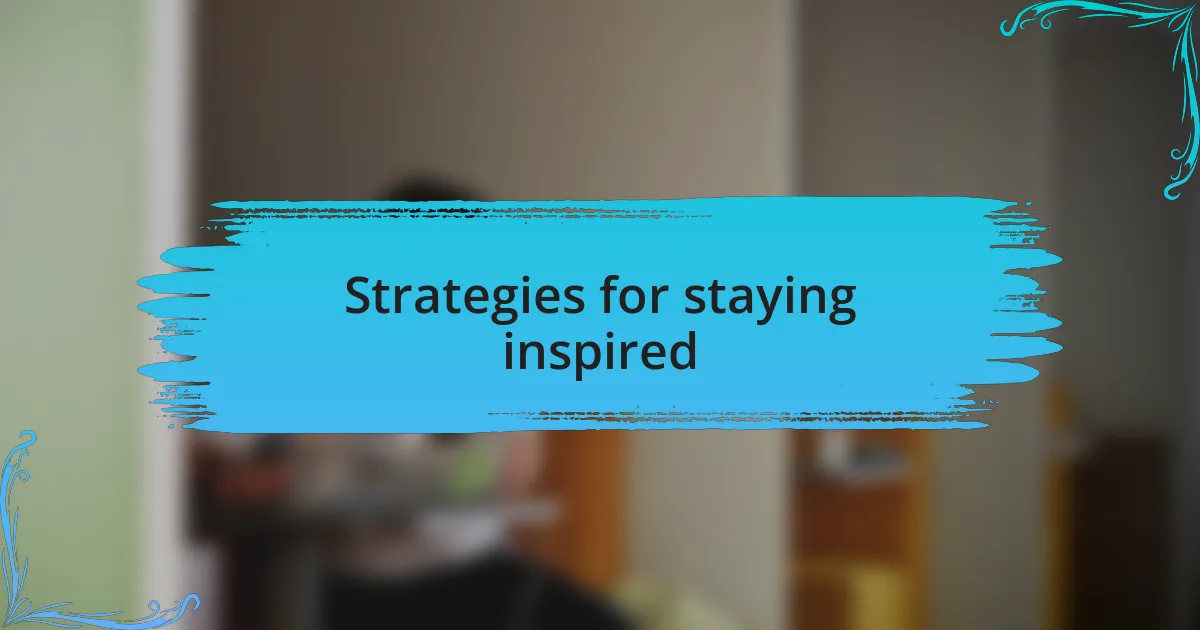
Strategies for staying inspired
To stay inspired during the prototyping phase, I often immerse myself in surrounding creativity. I’ve found that taking short breaks to explore design websites or browse through inspirations on platforms like Dribbble can spark new ideas. Have you ever noticed how just a quick glance at innovative work can transform your mindset? It recharges my thinking and helps me view my own project from fresh angles.
Another effective strategy for me is maintaining a visual inspiration board. I like to collect images, quotes, and even sketches that resonate with the feel I want for my app. Each time I look at this board, I feel a rush of motivation, and it reminds me of why I started this journey. How about you? Do you have a way to anchor your vision visually?
Engaging with peers in brainstorming sessions has also been a game changer. There are times when I felt stuck, and just bouncing ideas off a colleague opened up entirely new avenues. Those collaborative moments often feel electric, don’t they? It’s in those interactions that I often find not just solutions but the inspiration to explore ideas I hadn’t considered before.
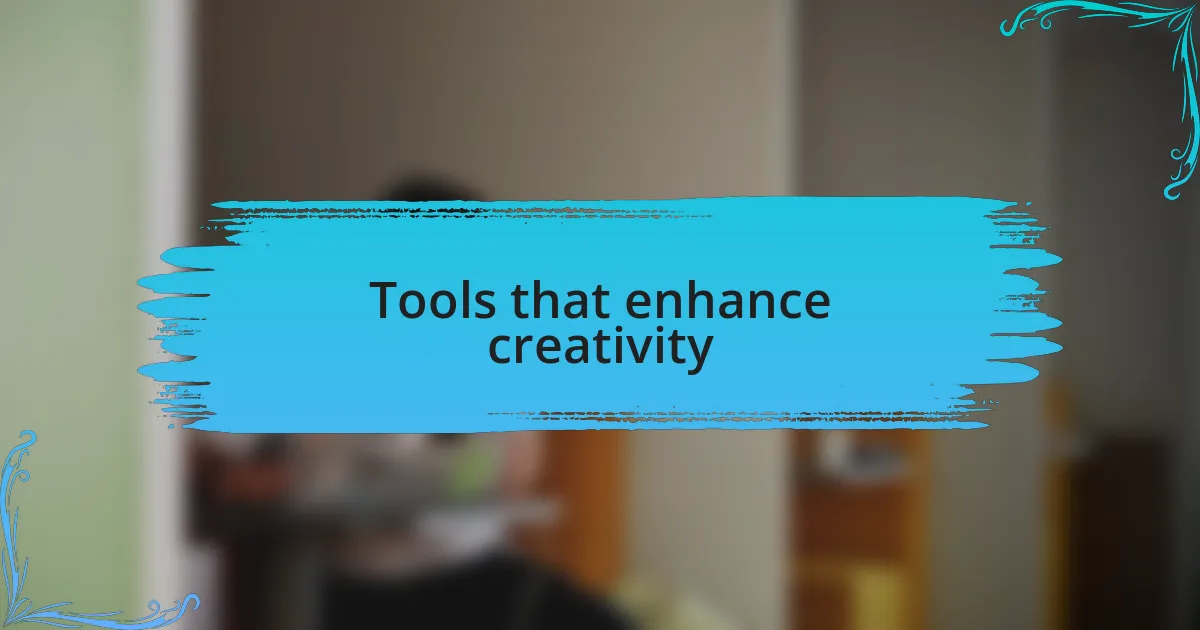
Tools that enhance creativity
When I dive into the prototyping phase, tools like Figma and Sketch become my best friends. They not only streamline the design process but also offer features that spark creativity, such as collaborative design and instant feedback. Have you ever found that experimenting with interactive elements pushes your creative boundaries? For me, the intuitive interfaces of these tools encourage me to try new layouts and styles that I might not have considered otherwise.
Another remarkable resource I’ve come to love is Milanote. This online platform allows me to arrange my thoughts and inspirations visually, giving me the freedom to organize ideas like a digital mood board. I find it incredibly fulfilling to drag and drop images or links, creating a visual narrative of my project. Isn’t it satisfying to see the concepts come to life, even before the coding starts?
Additionally, I often turn to sound design tools like Auphonic or Anchor to enhance my creative flow. Pumping up the ambiance with curated playlists or ambient sounds can significantly uplift my mood and help me focus. I still remember a session where I stumbled upon a fantastic lo-fi playlist; it transformed my workspace into a creative haven, and I found myself more productive than ever. What soundscapes do you tap into for inspiration?
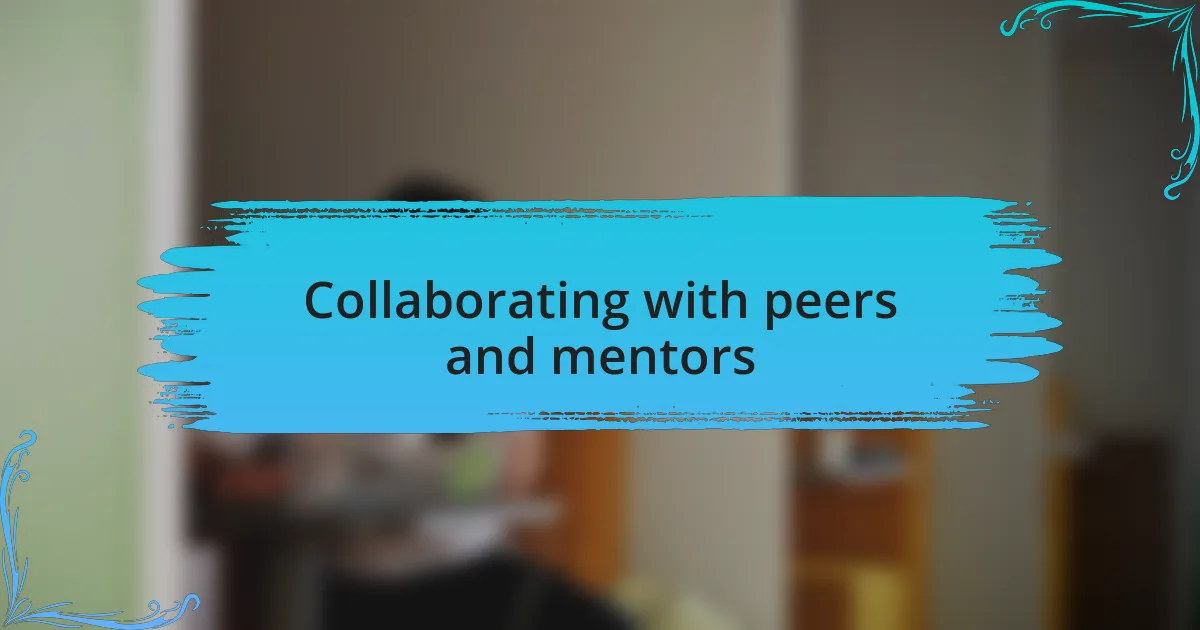
Collaborating with peers and mentors
Engaging with peers and mentors during the prototyping phase can be a game-changer. I recall a specific project where I bounced ideas off a mentor who had a wealth of experience. Their fresh perspective made me reconsider certain design choices, ultimately leading to a more refined prototype. Have you ever had a moment where someone’s feedback opened your eyes to a new possibility?
Collaboration also fosters a sense of accountability. When I share my prototypes with peers, I often feel a renewed motivation to enhance my work. Just the act of discussing my ideas with fellow developers ignites a spark of creativity. Isn’t it remarkable how much energy can come from a simple brainstorming session?
Don’t underestimate the power of diverse viewpoints. Recently, I participated in a coworking session where we critiqued each other’s prototypes. The variety of backgrounds among my peers brought invaluable insights that I wouldn’t have considered alone. How often do you tap into the strength of a collective creative brain?
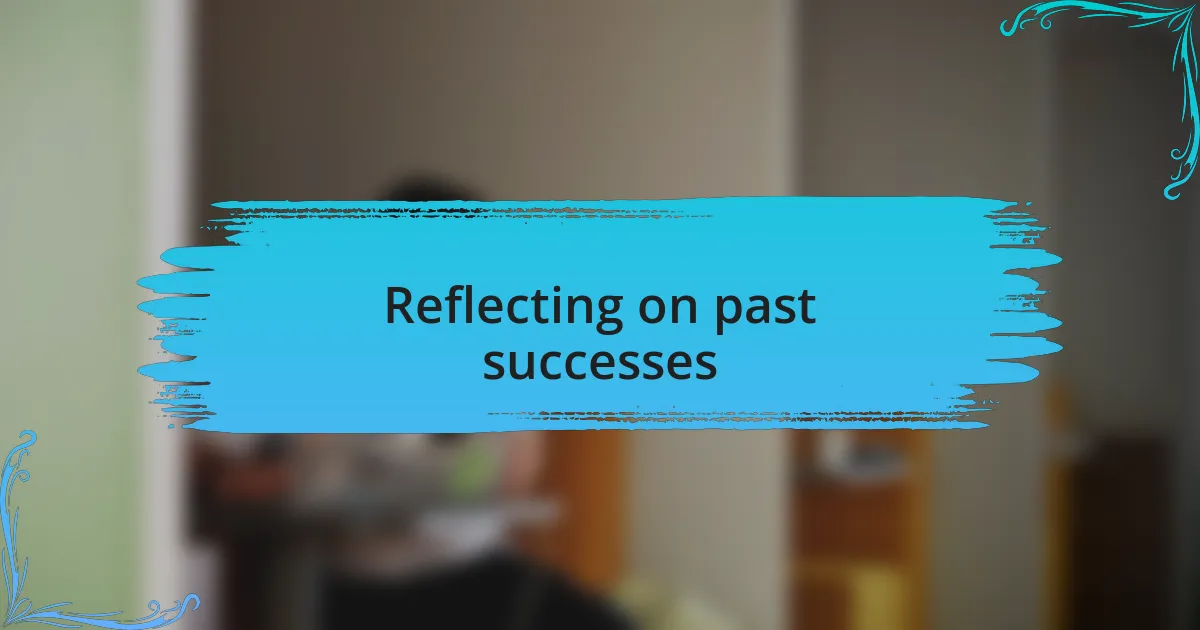
Reflecting on past successes
Reflecting on past successes is a powerful way to harness motivation during the prototyping phase. I can think back to a particular app I developed that received enthusiastic feedback from users. Revisiting those positive responses reminds me that my efforts can lead to meaningful outcomes, fueling my passion for exploring new ideas.
One method that always rejuvenates my creativity is reviewing projects that worked exceptionally well. I vividly remember one prototype that not only met the client’s expectations but exceeded them. This experience serves as a potent reminder that innovation often springs from lessons learned in the past. Isn’t it uplifting to reflect on achievements that once felt unattainable?
Additionally, I like to jot down what went right in previous projects in a dedicated notebook. This practice creates a small archive of inspiration I can turn to whenever I hit a creative block. The act of reading through these successes sparks a sense of pride and reminds me that every challenge is an opportunity waiting to unfold. Have you ever considered documenting your achievements for that burst of motivation?
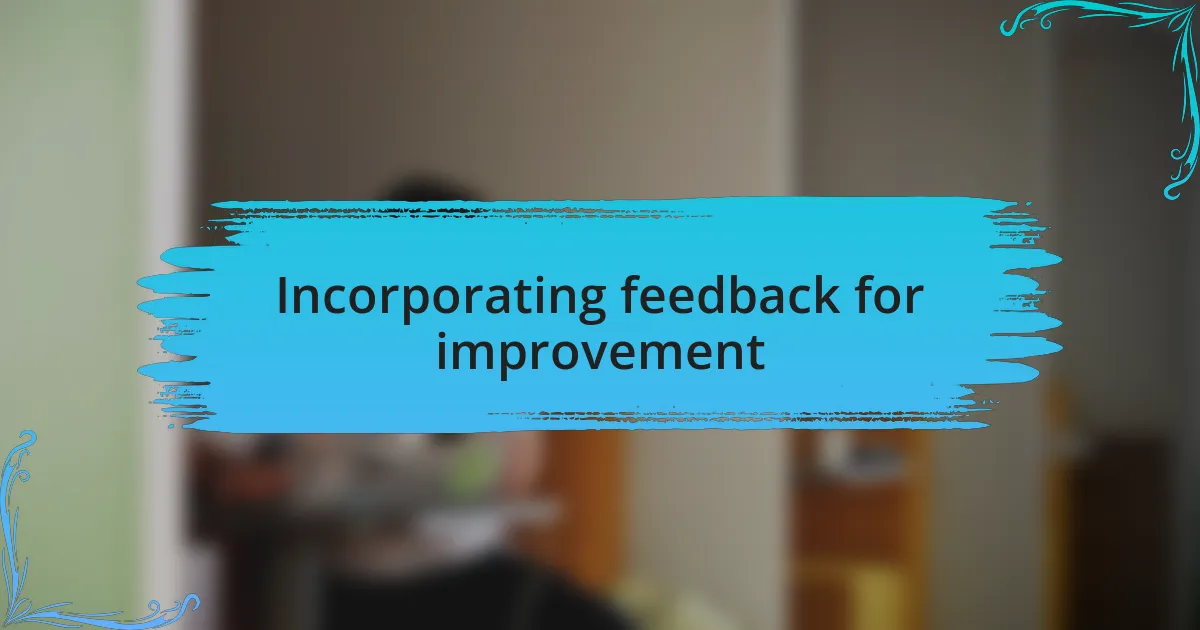
Incorporating feedback for improvement
Incorporating feedback during the prototyping phase is an essential practice that can dramatically enhance the project’s outcome. I recall an instance when I shared a concept with a small group of users early on. Their criticisms, while initially difficult to hear, led me to tweak key features, ultimately creating a more user-friendly interface. Isn’t it fascinating how a fresh perspective can reveal blind spots we might overlook?
When I engage with feedback, I often ask users specific questions about their experiences. By framing queries that dig deep, I encourage open dialogue. I once received feedback that a feature was cumbersome to access; it was surprising how a single suggestion helped me rethink the design for better accessibility. Have you found that the simplest adjustments can make the biggest impact?
I make it a point to document all the feedback I receive, whether it’s positive or negative. This habit not only informs my current project but also acts as a valuable reference for future developments. Reflecting on this feedback allows me to see patterns and areas for growth that might otherwise go unnoticed. Have you considered how much insight untapped feedback might hold for you?